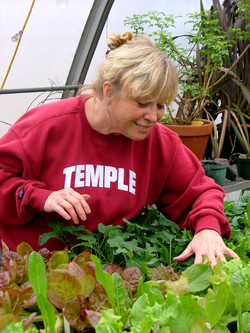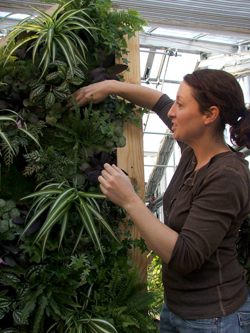Green thumbs
Landscape architecture and horticulture students and faculty take sustainable approach to this year’s Flower Show exhibit.
| For many, the thought of Italian gardens may evoke a certain structured image of sculpted trees and shrubbery, fountains, sculpture and pergolas. The concept of a sustainable garden, however, may elicit a decidedly different vision of naturally growing meadows or wetlands that burst with their own wild array of plant and animal life.
On the surface, it may seem a matter of “never the twain shall meet.” But, at the 2009 Philadelphia Flower Show — held March 1 through 8 at the Pennsylvania Convention Center — students and faculty in Temple University Ambler’s Department of Landscape Architecture and Horticulture will change the way people look at Italian gardens and sustainable garden concepts. Temple’s exhibit — “Green Renaissance: The Revival of Sustainable Living” — meshes perfectly with the Pennsylvania Horticultural Society’s 2009 Flower Show theme, “Bella Italia.” |
 Photo by James Duffy
Staff horticulturist Sheila Chlebda examines a variety of lettuces, which will be part of the kitchen garden.
|
|
“We took traditional 16th Century Italian Renaissance gardens as our inspiration and looked at ways of incorporating ideas of sustainability into that design right from the beginning,” said Baldev Lamba, associate professor of landscape architecture. “We wanted the exhibit to fully represent the values, goals, and mission of our campus, our department, and the university as a whole. Usually when you talk about sustainable gardens, you don’t readily think of formal design. Our exhibit takes the formal shape of the Italian gardens and uses it to share sustainable elements and concepts.” More than 35 students in the Department of Landscape Architecture and Horticulture’s Junior Design Studio and Horticulture Directed Studies program have been diligently working on the exhibit for several months, readying 4,000 individual plants from 120 different species. |
|
|
Temple at the Flower Show Tickets for the Flower Show vary in price, ranging from $13 to $22 for online ticket purchases and from $13 to $28 for purchases at the box office. For details, visit www.theflowershow.com. For more information on the horticulture and landscape architecture programs at Temple University Ambler, visit www.ambler.temple.edu/la-hort. |
The story that Ambler students and faculty would like to impart through their exhibit is one of sustainability. A walk through “Green Renaissance” is a walk through well-crafted examples of a variety of sustainable approaches to garden design. “We view the organization of the exhibit as a kind of journey through a three parterre Italian garden — the kitchen garden, the orchard, and the dry, or xeriscape, garden, each with their own water feature,” Lamba said. “We’re seeking to educate visitors at so many levels that ‘reduce, reuse, recycle,’ can be presented aesthetically and artistically.” While the kitchen garden and orchard promote growing and eating locally, other sustainable approaches are evident throughout the exhibit: copper aqueducts frame the entire exhibit to harvest rainwater; and the plants used in the exhibit were chosen because they could be reused in the gardens at the Ambler Campus. |
|
“One of our main goals is to help the homeowner implement the ideas that they see in the exhibit — how to start a home garden; how to eat locally; how to use native trees; how to use water conservatively,” said Denise Wood, a junior landscape architecture major. “Down to the signage itself, we are using sustainable techniques. We’re reusing existing frames and using low solvent ink. The signs will also be used in the campus arboretum after the Flower Show.” Junior Jennifer Gilbert said reusability was something “that we’ve put a lot of thought into from the start.” “With this project, you’re able to see an end result — the exhibit at the Flower Show — but we didn’t want it to end with that,” she said. “The heart of what we’re trying to convey is sustainability. We want the materials that we use for the exhibit to be used again. That was important to all of us.” This story originally appeared at www.temple.edu/ambler. Read the full story. |
 Photo by James Duffy
Landscape architecture junior Lisa Falls works on adding some finishing touches to the green wall, which will provide a backdrop for the water table, the central water feature of Temple University
Ambler’s “Green Renaissance” exhibit. |